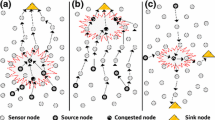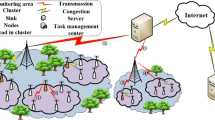Abstract
The ease of deployment of Wireless Sensor Networks (WSNs) makes them very popular and useful for data collection applications. Nodes often use multihop communication to transmit data to a collector node. The next hop selection in order to reach the final destination is done following a routing policy based on a routing metric. The routing metric value is exchanged via control messages. Control messages transmission frequency can reduce the network bandwidth and affect data transmission. Some approaches like trickle algorithm have been proposed to optimize the network control messages transmission. In this paper, we propose a collaborative load balancing algorithm (CoLBA) with a prediction approach to reduce network overhead. CoLBA is a queuing delay based routing protocol that avoids packet queue overflow and uses a prediction approach to optimize control messages transmission. Simulation results on Cooja simulator show that CoLBA outperforms other existing protocols in terms of delivery ratio and queue overflow while maintaining a similar end-to-end delay.













Similar content being viewed by others
Notes
The optimal number of packets on which the queueing delay is calculated is out of the scope of this paper. The only rational applied in this paper is to consider that queueing delay of recent packets is more important than that of old packets.
References
Tall, H., Chalhoub, G., & Misson, M. (2015). CoLBA: A collaborative load balancing algorithm to avoid queue overflow in WSNs. In IEEE DSDIS (pp. 682–687).
Song, M., Zhao, Y., Wang, J., & Park, E. K. (2009). A high throughput load balance algorithm for multichannel wireless sensor networks. In IEEE ICC (pp. 1–5).
Ren, F., He, T., Das, S., & Lin, C. (2011). Traffic-aware dynamic routing to alleviate congestion in wireless sensor networks. IEEE TPDS, 22, 1585–1599.
Palani, U., Alamelumangai, V., & Nachiappan, A. (2015). Hybrid routing and load balancing protocol for wireless sensor network. Wireless Networks, 22(8), 1–8.
Periyanayagi, S., & Sumathy, V. (2014). S-ARMA model for network traffic prediction in wireless sensor networks. Journal of Theoretical and Applied Information Technology, 60(3), 524–530.
Winter, T., Thubert, P., Brandt, A., Clausen, T., Hui, J., Kelsey, R., et al. (2011). RPL: IPv6 routing protocol for low power and Lossy networks. ROLL working group.
Levis, P., Patel, N., Culler, D., & Shenker, S. (2004). Trickle: A self-regulating algorithm for code maintenance and propagation in wireless sensor networks. In USENIX NSDI (pp. 15–28).
Kandris, D., Vergados, D. J., Vergados, D. D., & Tzes, A. (2010). A routing scheme for congestion avoidance in wireless sensor networks. In IEEE CASE.
Xie, M., & Gu, Y. (2010). Multipath routing algorithm for wireless multimedia sensor networks within expected network lifetime. In IEEE CMC (pp. 284–287).
Li, H., Cheng, Y., Zhou, C., & Zhuang, W. (2009). Minimizing end-to-end delay: A novel routing metric for multi-radio wireless mesh networks. In IEEE INFOCOM (pp. 46–54).
Wan, C., Eisenman, S., & Campbell, A. (2003). CODA: Congestion detection and avoidance in sensor networks. In ACM SenSys (pp. 266–279).
Sergiou, C., & Vassiliou, V. (2011). DAlPaS: A performance aware congestion control algorithm in Wireless Sensor Networks. In IEEE ICT (pp. 167–173).
Banimelhem, O., & Khasawneh, S. (2012). GMCAR: Grid-based multipath with congestion avoidance routing protocol in wireless sensor networks. Ad Hoc Networks, 10(7), 1346–1361.
Fang, W. W., Chen, J. M., Shu, L., Chu, T. S., & Qian, D. P. (2010). Congestion avoidance, detection and alleviation in wireless sensor networks. Journal of Zhejiang University Science C, 11(1), 63–73.
De Couto, D. S., Aguayo, D., Bicket, J., & Morris, R. (2005). A high-throughput path metric for multi-hop wireless routing. Wireless Networks, 11(4), 419–434.
Qiu, T., Feng, L., Xia, F., Wu, G., & Zhou, Y. (2011). A packet buffer evaluation method exploiting queueing theory for wireless sensor networks. Computer Science and Information Systems, 8(4), 1028–1049.
Patel, B. V., & Bisdikian, C. C. (1996). End-station performance under leaky bucket traffic shaping. IEEE Network, 10(5), 40–47.
Osterlind, F., Dunkels, A., Eriksson, J., Finne, N., & Voigt, T. (2006). Cross-level sensor network simulation with cooja. In IEEE LCN (pp. 641–648).
Dunkels, A., Gronvall, B., & Voigt, T. (2004). Contiki-a lightweight and flexible operating system for tiny networked sensors. In IEEE LCN (pp. 455–462).
Tall, H., Chalhoub, G., & Misson, M. (2016). Implementation and performance evaluation of IEEE 802.15. 4 unslotted CSMA/CA protocol on Contiki OS. Annals of Telecommunications, 71(9–10), 517–526.
Acknowledgements
This research was conducted with the support of the European Regional Development Fund (FEDER) program of 2014–2020, the region council of Auvergne, and the Digital Trust Chair of the University of Auvergne.
Author information
Authors and Affiliations
Corresponding author
Rights and permissions
About this article
Cite this article
Tall, H., Chalhoub, G., Hakem, N. et al. Load balancing routing with queue overflow prediction for WSNs. Wireless Netw 25, 229–239 (2019). https://doi.org/10.1007/s11276-017-1554-6
Published:
Issue Date:
DOI: https://doi.org/10.1007/s11276-017-1554-6




